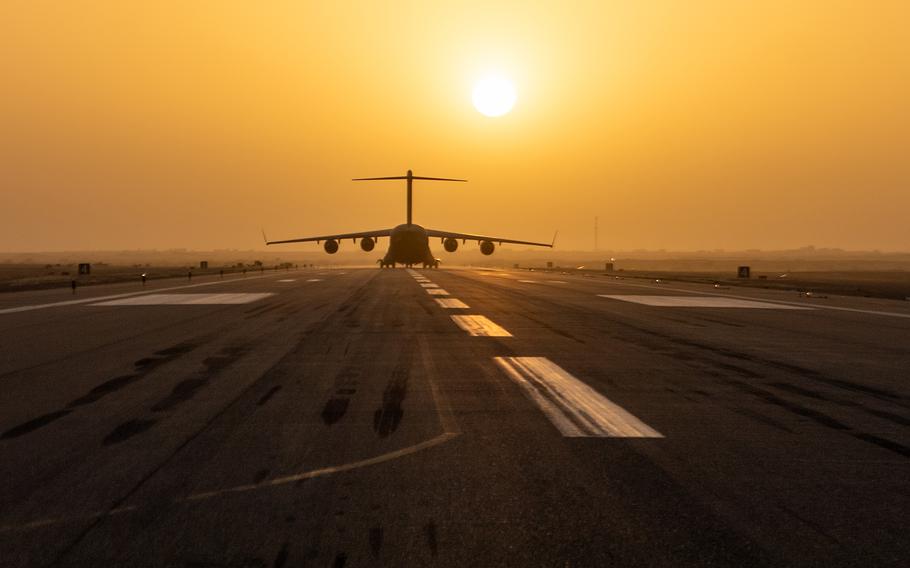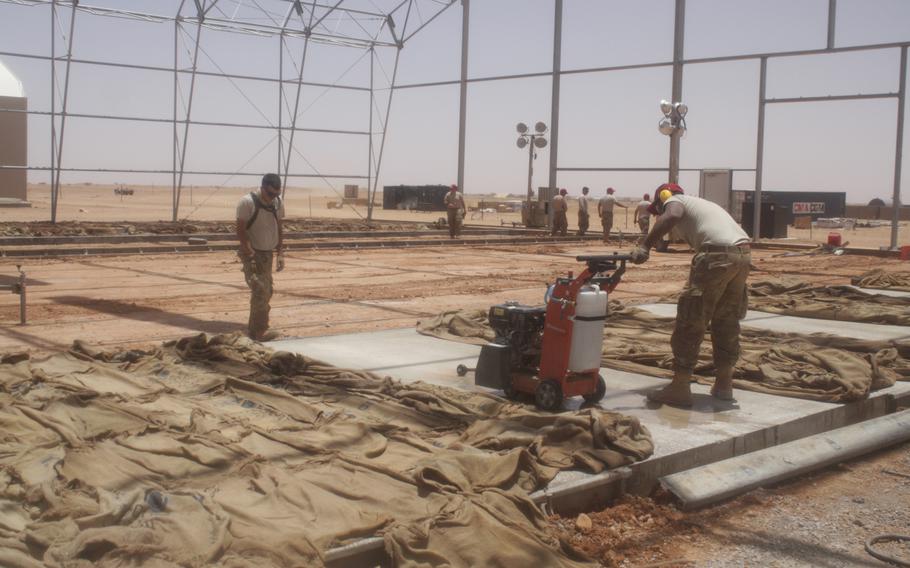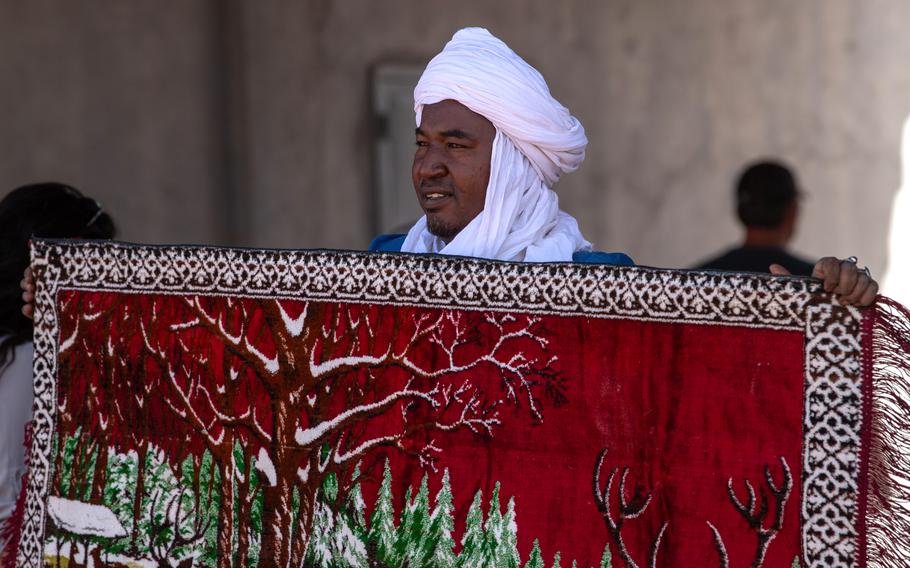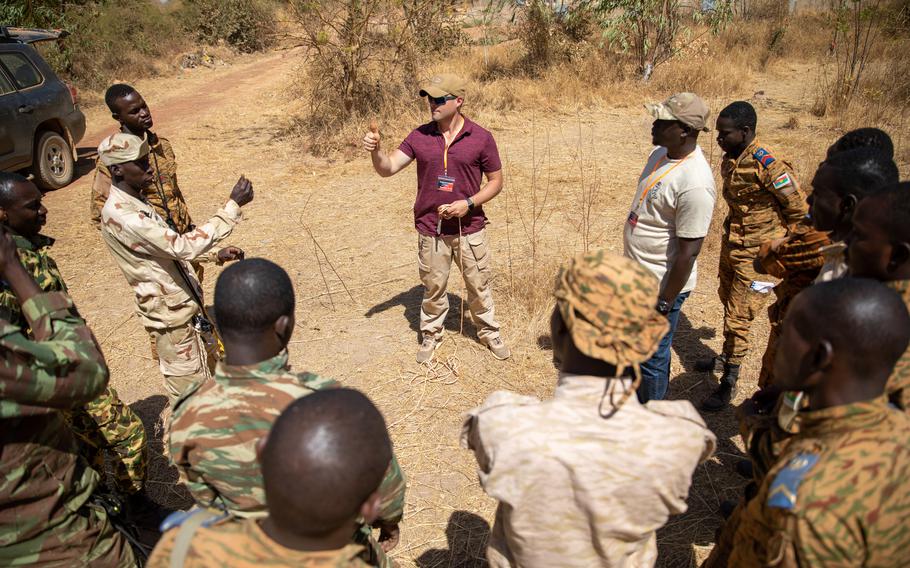
A NATO C-17 Globemaster III cargo aircraft, bringing personnel and cargo, taxis after landing at Air Base 201, Niger, Jan. 25, 2024. The Pentagon said April 22, 2024, that it is coordinating with Niger on the departure of more than 1,000 troops from the country. (Rose Gudex/U.S. Air Force)
The U.S. military is doubling down on its counterterrorism mission in western Africa, even as it faces eviction from strategic bases in Niger, a dwindling number of able partners and a terrorism threat that poses little danger to the American homeland.
U.S. Africa Command has been left scrambling for alternatives to carry out surveillance operations across an expanse of territory where terrorist attacks have been on the rise.
The Defense Department is coordinating with Niger on the departure of more than 1,000 troops from the country, which for years was the centerpiece of U.S. security strategy in the Sahel region before a July coup upended everything.
“We’ll continue to explore options to ensure that we can continue to conduct the kinds of counterterrorism, advising, assisting and operations that we need to,” Pentagon spokesman Maj. Gen. Pat Ryder said Monday.

Airmen work in what would become the unmanned aircraft apron at Air Base 201, in Agadez, Niger, in 2018. The area where drones would be parked when they were not in operation was part of an Air Force project that was touted as the largest airman-led construction effort in history. (John Vandiver/Stars and Stripes)
The turn of events in Niger comes only five years after the opening of a $110 million drone base in the city of Agadez, an Air Force project that was touted as the largest airmen-led construction effort in history.
“There is no avoiding that the loss of access to the two air bases in Niger is a setback not only for the United States, but also its allies and partners, both African and beyond,” said J. Peter Pham, who served as a special U.S. envoy to the Sahel during the Trump administration.
The U.S. campaign in Niger included a second drone base in the capital, Niamey. In the wake of the withdrawal from the country, a broader review of the American approach across the Sahel is needed, some analysts say.
But with the Pentagon already scouting basing alternatives in the region, which stretches across North Africa along the Sahara Desert, there has been no signal of any major strategy shift.
“That suggests to me that there is no pause,” said Cameron Hudson, a senior fellow at the Center for Strategic and International Studies. “There probably isn’t a whole lot of time for what I would consider to be a thoughtful reflection on what just happened. And that’s a little scary, quite frankly.”
While the U.S. carries out a wide range of aid and development efforts in Niger and across the Sahel region, American military activities get much of the attention.

An Agadez vendor displays a rug during a bazaar at Air Base 201, Niger, March 2, 2024. A split with the U.S. means that Niger can expect to lose out on the hundreds of millions in aid it has received from the U.S. in recent years, possibly hurting the people of Niger economically. (Rose Gudex/U.S. Air Force)
Operations have been going on there for decades, picking up momentum after 9/11, when the idea of nipping in the bud terrorism threats in far-flung places became a focal point.
But while terrorism concerns brought U.S. forces to the region, the threats posed across the Sahel are largely localized, analysts argue.
“There’s a real possibility that we have overinflated and overstated the direct threat to vital U.S. interests in the region and beyond,” Hudson said.
A mix of militant groups operates across the Sahel, some of which advertise themselves as affiliates of the Islamic State or al-Qaida.
But the groups bear little resemblance to the parent terrorist organizations that made their names carrying out attacks such as those on Sept. 11, 2001, or the ISIS march across Iraq and Syria several years ago.
Most of the groups operating in the Sahel predate organizations such as ISIS, said Joseph Siegle, director of research for the Africa Center for Strategic Studies in Washington.
“They have their own ideology, their own leadership structure, their own funding mechanisms,” he said. “They’re recruiting local fighters. And their aims are local for the most part.”
Some groups may posture ties to ISIS or Al-Qaida for street credibility, but they’re not taking directions from above, he said.
Hudson added that those local groups are made up almost exclusively of disgruntled young people from the region who are frustrated by a lack of economic opportunity.

U.S. Army Staff Sgt. Keegan Bracewell teaches an explosive ordnance disposal class to Burkinabe soldiers in Pissy, Burkina Faso, in 2021. The country, in Africa’s Sahel region, is one where a coup has complicated U.S. efforts to coordinate with the government. (Nathan Hammack/U.S. Army)
“They really are seen as the sons of families in this region who have no other options in life,” Hudson said.
But how that relates to vital American interests and threats to the homeland isn’t obvious or direct, and the U.S. could be overemphasizing the military’s role there, he said.
In the Sahel, a string of coups has complicated U.S. efforts to coordinate with governments, not only in Niger but also in Mali and Burkina Faso.
Last week, another U.S. partner in Africa, Chad, made threats about denying access to a base where a small number of U.S. troops operate. While it’s not yet clear how that situation will play out, the broader picture shows the United States losing sway.
The turmoil also has opened the door to more Russian influence in the region, where Moscow has dispatched government-aligned military contractors and elements of its armed forces to various places.
In the countries where military coups toppled elected governments, growing collaboration with the Russians is largely “a regime protection racket,” Siegle said.
“Basically, the Russians come help these regimes stay in power,” he said. “That works for the regime; that works for the Russians. But in the process, it’s an extractive relationship and it’s the citizens that are suffering,” he said.
Meanwhile, the Russians have not demonstrated interest in dedicating the kinds of resources and development aid that have been a feature of the U.S. strategy.
A split with the U.S. means that Niger can expect to lose out on the hundreds of millions in aid it has received from the U.S. in recent years, Pham said.
“In the long run, it will be the people of Niger who pay the price for the junta’s choices,” he said.